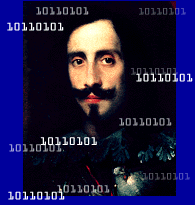| "...the most magnificent
portraits of that age." |
Anthony Van Dyck was born on March 22, 1599, in Antwerp, son
of a rich silk merchant. The young Van Dyck’s artistic talent was already obvious
when at age 11 he was apprenticed to the Flemish historical painter named Hendrik
van Balen. He was admitted to the guild of painters in Antwerp during 1618 when he
was 18 years of age. He spent the next two years as a member of the workshop of Peter Paul
Rubens in Antwerp. Van Dyck's work during this period is very similar in style to
Rubens, and several paintings originally attributed to Rubens have since been discovered
to be the work of Van Dyck.
From 1620 through 1627 van Dyck travelled in Italy. He was in great
demand as a portraitist and it was in Italy that he developed his style that was copied by
so many others. He toned down the rounded robustness he had learned from Rubens to
concentrate on a more dignified, elegant manner. His portraits of Italian aristocrats are
some of the most magnificent portraits of that age. There were men on prancing horses or
shimmering armour, ladies in black gowns. He created very idealised figures with proud,
erect stances, slender figures, and the famous expressive "van Dyck" hands. He
was greatly influenced by the great Venetian painters Titian, Paolo Veronese, and Giovanni
Bellini. Van Dyck adopted colours of great richness with jewel - like purity. No
other painter of any age surpassed Van Dyck at portraying the shimmering whites of
satin, the smooth blues of silk, or the rich crimsons of velvet. He was the quintessential
painter of aristocracy.
Van Dyck was extremely successful during his time in Genoa. It was
in Genoa that Van Dyck showed his brilliant capability of creating idealistic
portraits of his subjects. At the same time Van Dyck developed the repertoire of
portrait styles that served him so well when he was appointed to the court of Charles I of
England.
He returned to Antwerp in 1627. By 1630, Van Dyck was appointed to
the court of Archduchess Isabella Clara Eugenia. During this time known as his second
Antwerp period, Van Dyck worked as a portraitist and a painter of church pictures.
Van Dyck also adopted the heightened emotionalism he had observed in the works of
Guido Reni. During this same period he also did some work with Rubens. Again, many of his
works were falsely attributed to the hand of Rubens.
In 1632 he moved to London and was appointed "Principal
Painter" to King Charles I, who knighted him shortly after his arrival. The knighted
Sir Anthony Van Dyck was granted a house a Blackfrairs. He painted some of the
English aristocracy of the time, but far fewer paintings than are accepted as genuine by
most Van Dyck experts. He had a number of assistants that painted under his
supervision and nearly all of their paintings were attributed to the hand of Van Dyck
through the centuries. The style of Van Dyck became lighter and more luminous, with
somewhat thinner paint and even more sparkling highlights in gold and silver.
He visited Antwerp in both 1634 and in 1640, but returned to London in
ill health where he died on December 9 of 1641. Van Dyck was certainly the most
influential 17th-century painter of England. He developed a unique style and founded the
"English School" of painting. The famous English portraitists Sir Joshua
Reynolds and Thomas Gainsborough were his artistic heirs and follower of his style.
|

